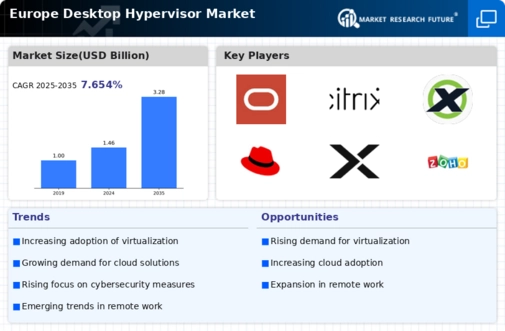Expansion of Cloud-Based Solutions
The expansion of cloud-based solutions is a significant driver for the desktop hypervisor market in Europe. As businesses increasingly migrate to cloud environments, the demand for virtualization technologies that facilitate seamless integration with cloud services is on the rise. Desktop hypervisors enable organizations to deploy virtual desktops in the cloud, providing flexibility and scalability that traditional solutions cannot match. This trend is underscored by a 35% increase in cloud adoption among European enterprises, which is likely to continue as companies seek to enhance their operational efficiency. The desktop hypervisor market is thus positioned to benefit from this shift, as more organizations recognize the advantages of cloud-based virtualization in supporting their digital transformation initiatives.
Growing Emphasis on Cost Efficiency
Cost efficiency remains a critical driver for the desktop hypervisor market in Europe. Organizations are increasingly recognizing the financial benefits of virtualization technologies, which can lead to substantial savings in hardware and operational costs. By consolidating multiple desktop environments onto a single physical machine, companies can reduce their IT expenditures significantly. Recent studies indicate that businesses utilizing desktop hypervisors can achieve up to 40% savings in hardware costs. This financial incentive is compelling, particularly for small and medium-sized enterprises (SMEs) that are looking to optimize their budgets. The desktop hypervisor market is thus positioned to grow as more organizations seek to leverage these cost-effective solutions, allowing them to allocate resources more strategically and invest in other critical areas of their operations.
Rising Demand for Remote Work Solutions
The desktop hypervisor market in Europe experiences a notable surge in demand for remote work solutions. As organizations increasingly adopt flexible work arrangements, the need for virtualization technologies that enable employees to access their desktops from various locations becomes paramount. This trend is reflected in a 30% increase in the adoption of desktop virtualization solutions across European enterprises. The ability to maintain productivity while ensuring data security is driving investments in desktop hypervisors, as companies seek to provide seamless access to applications and data. Furthermore, the desktop hypervisor market is witnessing innovations that enhance user experience, making remote work more efficient and effective. This shift not only supports employee satisfaction but also aligns with broader organizational goals of agility and resilience in the face of changing work environments.
Technological Advancements in Virtualization
Technological advancements play a pivotal role in shaping the desktop hypervisor market in Europe. Innovations in virtualization technologies, such as improved performance, enhanced scalability, and better integration with cloud services, are driving the adoption of desktop hypervisors. The introduction of features like GPU virtualization and support for high-performance applications is particularly appealing to industries that require robust computing capabilities. As organizations seek to leverage these advancements, the desktop hypervisor market is expected to expand, with a projected growth rate of 25% over the next five years. This growth is indicative of the increasing reliance on advanced virtualization solutions to meet evolving business needs and technological demands.
Increased Focus on Compliance and Data Protection
The desktop hypervisor market in Europe is significantly influenced by the heightened focus on compliance and data protection regulations. With stringent laws such as the General Data Protection Regulation (GDPR) in place, organizations are compelled to adopt technologies that ensure data security and compliance. Desktop hypervisors offer robust security features, including data encryption and access controls, which are essential for safeguarding sensitive information. As a result, the market is witnessing a shift towards solutions that not only enhance operational efficiency but also align with regulatory requirements. The desktop hypervisor market is thus likely to see increased investments as companies prioritize compliance, ensuring that their virtualization strategies are both effective and legally sound.

















Leave a Comment